By Angel Tobar
Amidst the bustling urban landscape of New York City, the Bronx stands out not only for its rich cultural heritage but also for its green transformation. In the concrete jungle, a remarkable movement has taken root, breathing life into the borough’s neighborhoods while fostering unity, education, and access to fresh produce. Community farms and gardens have become the heartbeat of the Bronx, redefining how residents interact with their environment and each other. These oases of greenery are more than just spaces for cultivation; they are engines of empowerment and agents of change.
At first glance, the Bronx might seem an unlikely host for community farms and gardens. However, this borough, often overshadowed by its neighbors, is home to a growing network of these vibrant spaces. Abandoned lots and neglected spaces have been transformed into thriving gardens, fostering a sense of pride and connection within the community.
Sheryll Durant, a passionate advocate for urban agriculture and the driving force behind New Roots Community Farm, envisions a brighter future for her community. “It’s about taking control of our food systems, our neighborhoods, and our lives,” Durant explains. “Our farm, nestled within the urban fabric of the Bronx, is not just a place to cultivate crops, it’s a sanctuary of growth, knowledge-sharing, and community engagement.”
The significance of community gardens in the Bronx extends far beyond their current impact. Throughout the borough’s history, these green spaces have played a vital role in shaping communities, providing a respite from urban challenges, and fostering unity. The documentary “Decade of Fire” sheds light on the complex history of the Bronx in the 1970s, a period marked by urban decay and neglect.
The documentary highlights how community gardens emerged as symbols of hope and resilience during a time of crisis. As residents faced abandoned buildings, fires, and neglect, they transformed vacant lots into vibrant gardens. These gardens weren’t just about cultivating crops; they were a way for the community to reclaim its neighborhoods, build connections, and counter the narrative of neglect.
New Roots Community Farm stands as a continuation of this legacy. While the challenges faced by the Bronx have evolved, the spirit of unity and empowerment remains at the heart of these green spaces. Just as community gardens in the past provided a sanctuary for residents to gather and grow, New Roots and similar initiatives offer a space for education, connection, and positive change.
While the impact of community farms and gardens on the Bronx is evident, the journey has not been without its challenges. One of the primary hurdles faced by urban agriculture initiatives is the issue of land access. The scarcity of available land, coupled with rising property values, presents a significant barrier for those seeking to establish or expand community gardens.
“Land is a precious resource in our borough,” says Ana Garcia, a community member and longtime advocate for community gardens in the Bronx. “We need to find innovative ways to secure spaces for community gardens and farms to thrive.”
In addition to land access, funding remains a critical concern for sustaining these initiatives. Community gardens and farms often rely on grants, donations, and community support to cover expenses such as seeds, tools, and infrastructure. Securing consistent funding can be a daunting task, particularly in underserved neighborhoods where financial resources may be limited.
The success of community farms like New Roots has caught the attention of city officials, leading to the establishment of the Mayor’s Office of Urban Agriculture (MOUA). This department recognizes the potential of these initiatives and has forged partnerships to amplify their impact.
Through collaborative efforts, the urban agriculture department is fostering a green revolution in the Bronx. By supporting community farms and initiatives like New Roots, it is driving positive change, one garden at a time. These partnerships provide a lifeline for community farms, helping to address challenges related to land access and funding.
The transformation of the Bronx’s landscape is a testament to the power of collective effort and community-driven initiatives. As community farms continue to sprout and flourish, a new narrative is being written—one that celebrates unity, growth, and resilience.
Looking ahead, the momentum shows no signs of slowing down. The collaboration between grassroots initiatives like New Roots Community Farm and the urban agriculture department continues to yield innovative programs and strategies. As the Bronx continues to evolve, the legacy of these community farms will stand as a testament to what can be achieved when passion meets purpose.
In the Bronx, the city’s concrete is giving way to the vibrant hues of flourishing gardens. The transformation is more than aesthetic; it’s about reclaiming spaces, fostering community resilience, and nourishing both body and soul. Community farms and gardens are the embodiment of collective effort, reflecting a desire for positive change that resonates deeply within these neighborhoods. Through these green spaces, the Bronx is sowing the seeds of a brighter, more sustainable future—one that’s rooted in unity and growth.



